Do you dream of owning a horse?
Can you picture yourself galloping through fields and forming a deep bond with your equine companion?
Owning a horse is an incredibly rewarding experience, but it also comes with the responsibility of providing proper daily care. It takes time, dedication, and a whole lot of love to keep our horses happy and healthy – 365 days a year!
Every horse and every barn is different, so routines will naturally vary depending on your climate, facilities, and individual horse’s needs. However, there are essential basics that every horse requires for their physical and mental well-being. Remember, horses aren’t machines; they’re living creatures with emotions and needs just like us. They take care of us in the saddle, so it’s our job to ensure they’re well looked after.
That’s where having a solid daily care routine comes in! Once you understand the essential aspects of horse care, having a checklist can be a lifesaver. It ensures you don’t miss anything, makes barn chores more efficient, and ultimately saves you time.
I’ve created a free printable checklist with a daily horse care routine for both morning and evening, especially helpful during good weather when horses are typically turned out during the day and stabled at night. You can grab it at the bottom of this post!
Of course, your specific routine will depend on how you keep your horse. Whether you have your horse at home, at a full boarding facility, or on pasture with a run-in shed, the key is to ensure they’re receiving proper care and that the facilities are well-maintained.
But before we dive into the daily routine, let’s quickly touch on the five fundamental needs of every horse:
- Food: A balanced diet is crucial for a horse’s health and energy levels. This primarily consists of good quality forage like hay or pasture, with additional grain or concentrates as needed based on the horse’s age, workload, and individual requirements.
- Water: Staying hydrated is essential for nearly every bodily function in a horse. They need access to fresh, clean water at all times to prevent dehydration and potential health issues like colic.
- Shelter: Horses need protection from harsh weather conditions like wind, rain, extreme cold, and intense sun. This doesn’t necessarily mean keeping them stalled; a run-in shed or access to a well-ventilated stable can provide the necessary shelter while allowing them freedom of movement.
- Exercise: In the wild, horses roam for miles each day. While we may not be able to replicate that exact lifestyle, providing adequate turnout time and space for movement is crucial for their physical and mental health. Exercise strengthens their bones, muscles, and tendons, and allows them to express their natural behaviors.
- Companionship: Horses are social creatures that thrive in herds. Isolation can lead to stress and behavioral issues. Ensuring your horse has equine companions, whether in a pasture or with neighboring horses in stalls, is vital for their well-being.
Now that we’ve covered the basics, let’s get into the details of a daily horse care routine that will keep your horse happy, healthy, and thriving!
Feeding: Keeping Your Equine Partner Fueled and Happy
Alright, let’s talk about one of the most important aspects of horse care: feeding! It’s not as simple as just throwing some hay in a bucket. We need to make sure our horses are getting the right balance of nutrients and calories to stay healthy and perform at their best.
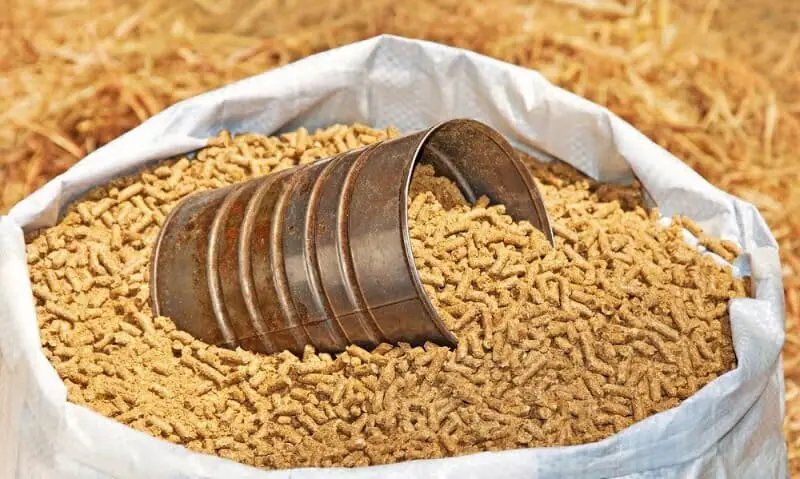
Grain Feeding
First things first, not every horse needs grain. Some do just fine on good quality hay or pasture. But for those who need a little extra oomph, like hard keepers or horses in heavy work, grain can be a valuable source of concentrated energy and protein.
Now, here’s the golden rule: always split your horse’s grain ration into at least two meals a day. Their stomachs are small, and their digestive systems are designed for small, frequent meals.
If your horse gets a hefty amount of grain, dividing it into three or even four meals is even better. This helps prevent colic, founder, and other digestive issues.
Here’s a quote that always sticks with me from TheHorse.com:
“DON’T feed more than 11 pounds of grain per day, or 4-5 pounds of grain per feeding or the horse’s colic risk increases sixfold.”
TheHorse.com (Horse Feeding Basics)
The amount and type of grain you feed depends on your horse’s individual needs, like their weight, body condition, age, workload, and any special considerations like metabolic issues. Always consult with your vet to determine the best feeding program for your equine partner.
Important: And remember, if your horse has been ridden, give them at least an hour to cool down before their grain meal.
Supplements
Supplements can be a great way to fill in any nutritional gaps or address specific needs, but they shouldn’t be a band-aid for underlying issues. Before reaching for a supplement, make sure your horse’s overall health, diet, and management are on point.
Here are some situations where supplements might be beneficial:
- Joint health: If your horse has arthritis or stiffness, joint supplements can provide support and improve comfort.
- Hoof health: Supplements with biotin and other key nutrients can promote strong, resilient hooves.
- Nutritional deficiencies: If your horse isn’t getting all the essential vitamins and minerals from their hay or pasture, a balanced supplement can help.
- Weight gain: For horses who need to put on weight but shouldn’t get more grain, weight gain supplements can be helpful.
- Digestive support: Supplements with prebiotics and probiotics can aid in gut health and digestion.
Remember, always do your research and choose high-quality supplements that are appropriate for your horse’s specific needs.
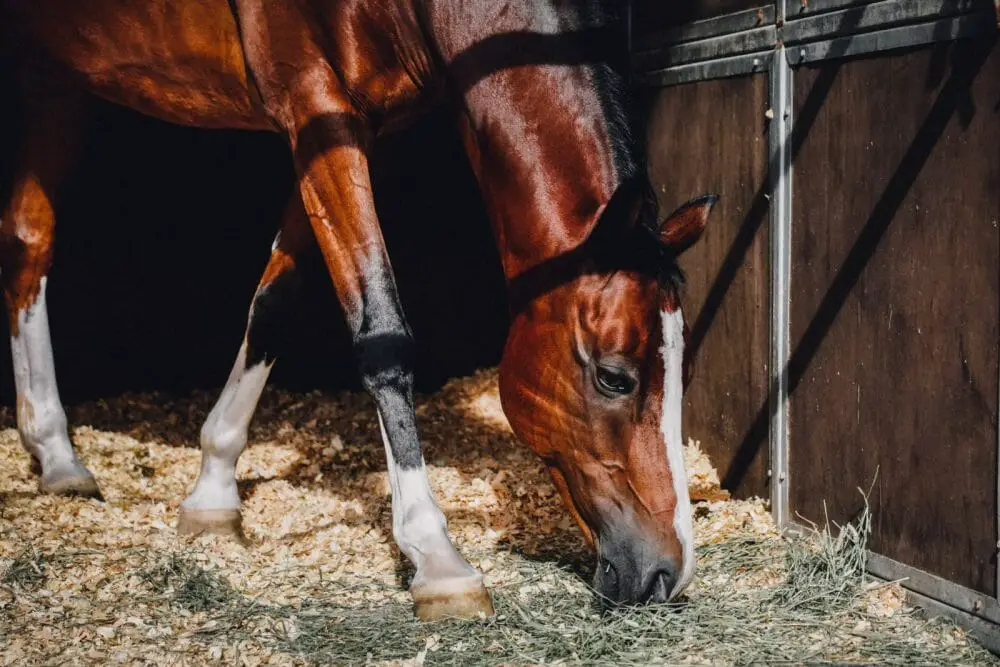
Hay Feeding
Forage, like hay or pasture, should be the foundation of every horse’s diet. Their digestive systems are designed to graze throughout the day, so providing them with free-choice hay is ideal if they don’t have 24/7 access to pasture. This helps keep their gut healthy and prevents ulcers.
The amount of hay your horse needs depends on their individual needs, but generally, they should consume 1.5% to 2.5% of their body weight in forage daily.
Make sure you’re feeding good quality hay and get a hay analysis done to understand its nutritional content. This will help you balance your horse’s diet with the appropriate grain and supplements.
A few precautions to keep in mind:
- Always check hay for mold and dust before feeding it.
- Avoid feeding hay on sandy ground to prevent sand colic.
- If your horse is a fast eater, consider using a slow feeder hay net.
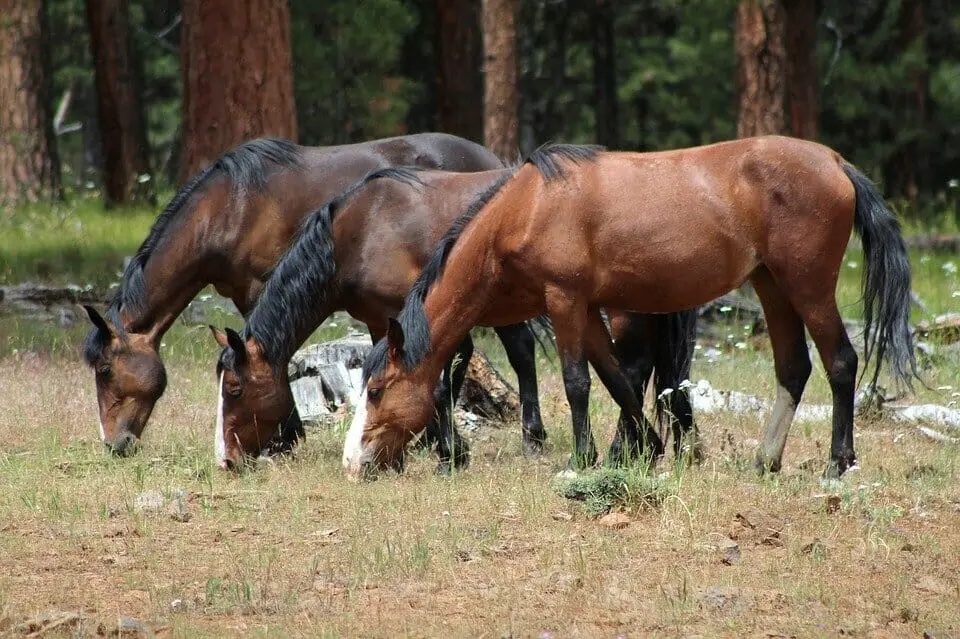
Ensuring Freedom from Competition
Horses can get pretty competitive when it comes to food, especially in herd environments. This can lead to dominant horses hogging the hay and lower-ranking horses not getting their fair share.
Here’s how to minimize food competition:
- Feed grain in separate stalls or tie horses up while they eat.
- Use feed bags for individual feeding in group settings.
- Spread hay piles out in different areas of the pasture or paddock.
- Consider individual turnout if necessary.
- For horses who are overly dominant or tend to overeat, you might need to try a grazing muzzle or slow feeder hay net.
By providing a balanced diet, spreading the meals throughout the day and minimizing food competition, you’ll be setting your horse up for a healthy and happy life!

Watering: The Lifeblood of a Healthy Horse
Water, water everywhere, and not a drop to… wait, that’s not how it goes for our equine friends! Clean, fresh water is absolutely vital for horses. It’s involved in practically every bodily function, from digestion and temperature regulation to joint lubrication and overall health. Dehydration can lead to serious problems like impaction colic and kidney issues, so we need to make sure our horses are staying hydrated.
Importance of Fresh Water
Horses are picky about their water, and who can blame them? They prefer it fresh and clean, just like we do. If the water is dirty or stale, they might not drink enough, putting them at risk for dehydration. Always make sure your horse has access to clean water sources, whether it’s a bucket in the stall or an automatic waterer in the pasture.
Quantity Requirements
So, how much water does a horse actually need? The average horse drinks about 8-12 gallons per day, but this can vary depending on factors like weather, workload, and diet. Hot weather, exercise, and a diet high in dry forage will all increase their water needs.
Maintaining Clean Water Sources
Keeping water clean is an ongoing task.
Here’s the drill:
- Empty and scrub: Dump out any remaining water and give the bucket or trough a good scrub with a brush to remove any algae or grime.
- Rinse and refill: Rinse it thoroughly and refill with fresh, clean water.
Automatic waterers also need regular cleaning and maintenance to prevent bacteria buildup and ensure they’re functioning properly.
Salt and Mineral Blocks
Salt and minerals are essential for electrolyte balance and overall health. Horses should have free access to both a salt block (usually white) and a mineral block (typically red). You can mount them on the stall wall or use a ground holder in the pasture.
If you notice your horse licking or chewing on trees, wood, dirt, or even manure, it could be a sign they’re lacking salt or minerals. Make sure they have access to these blocks and monitor their intake, especially during hot weather when they lose electrolytes through sweat.
Remember, providing your horse with plenty of fresh, clean water is one of the most important things you can do to keep them healthy and happy!
Give Adequate Turnout Time And Space
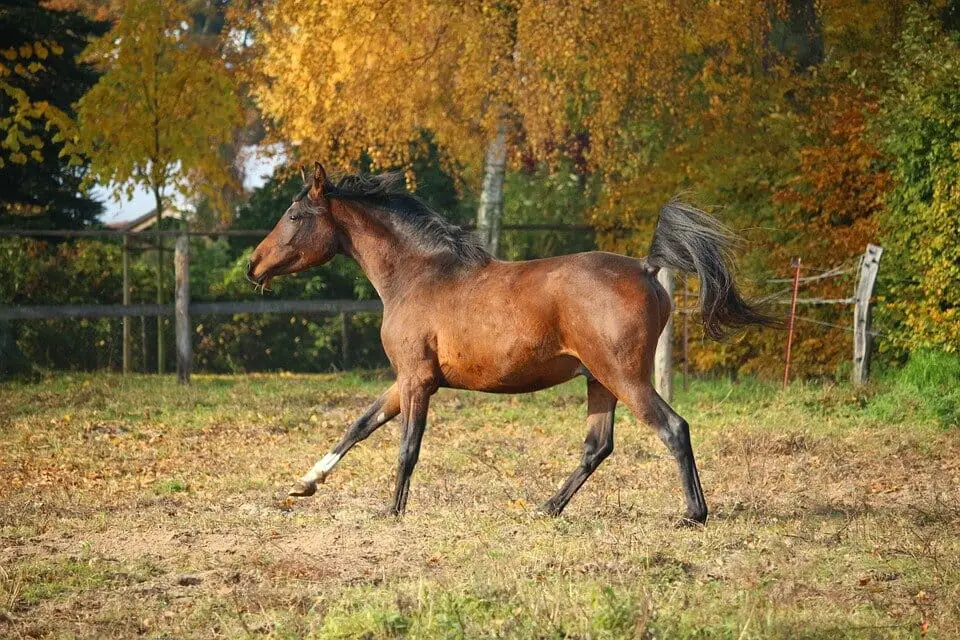
Turnout and Exercise: Letting Horses Be Horses
Alright, folks, let’s talk about one of the most important aspects of horse care: turnout and exercise! Horses are meant to move, and giving them ample opportunity to do so is crucial for their physical and mental well-being.
Benefits of Turnout:
Think about it: in the wild, horses roam for miles each day, grazing and socializing with their herd. While we may not be able to replicate that exact lifestyle for our domesticated horses, providing them with turnout time is the closest we can get. Here’s why it’s so beneficial:
Physical Health: Turnout allows horses to stretch their legs, strengthen muscles and tendons, and maintain healthy joints. It also helps prevent stiffness and promotes good circulation.
Mental Health: Being cooped up in a stall all day can be stressful for a horse. Turnout provides mental stimulation, allows them to express natural behaviors, and simply lets them be horses! This can lead to a happier, more relaxed horse both in and out of the saddle.
Space Requirements:
The amount of space your horse needs for turnout depends on a few factors, such as their individual energy level, size, and whether they’re turned out with other horses. A small paddock might be fine for a quiet horse, while a more energetic horse will need a larger pasture to really stretch their legs and gallop. Remember, a cramped space can lead to frustration and potential injuries.
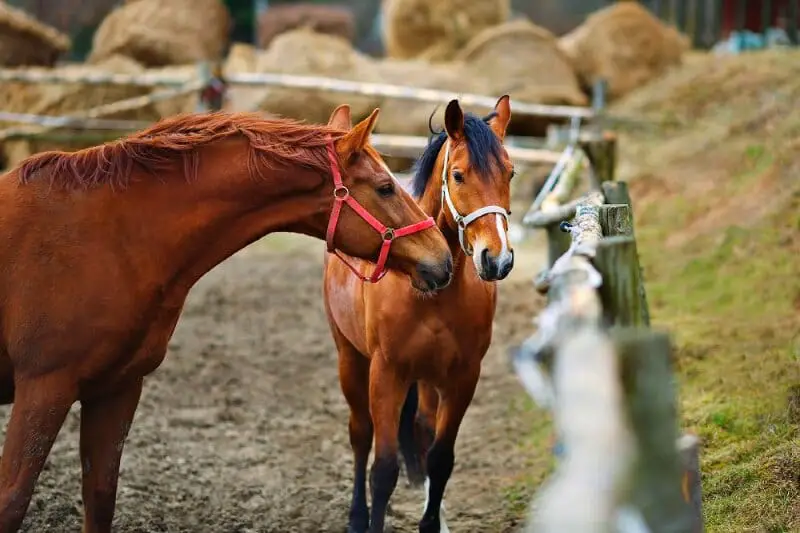
Companionship and Herd Dynamics:
As I mentioned before, horses are herd animals, and companionship is vital for their well-being. Turning your horse out with other horses allows them to socialize, play, and establish a hierarchy within the herd. This is all part of their natural behavior and contributes to their mental and emotional health.
Of course, herd dynamics can be tricky. Keep an eye out for any bullying or aggressive behavior, especially when it comes to food and resources. If necessary, you might need to separate certain horses or adjust the turnout arrangements to ensure everyone’s safety and well-being.
Bottom line: prioritize turnout! It’s one of the best things you can do for your horse’s overall health and happiness.

Fly Control: Battling the Pesky Buzzers
Ugh, flies! The bane of every horse owner’s existence, especially during the warmer months. These little buggers are more than just annoying; they can carry diseases, cause skin irritations, and even lead to intestinal parasites if horses ingest their eggs. So, let’s talk about some effective fly control methods to keep our equine friends comfortable and healthy.
Fly Spray and Other Methods:
Fly Spray: This is your first line of defense. There are tons of different fly sprays on the market, so find one that works well for your horse and the type of flies you’re dealing with. Be sure to apply it as directed, paying close attention to areas where flies tend to congregate, like the face, belly, and legs.
Feed-Through Fly Control: These supplements contain ingredients that pass through the horse’s manure and disrupt the fly life cycle by preventing larvae from developing. They can be a helpful addition to your fly control arsenal.
Manure Management:
Flies love manure! It’s their breeding ground, so keeping things clean is crucial.
Here’s what you can do:
- Regular Mucking: Pick stalls daily and remove manure from paddocks and pastures regularly, ideally at least once a week. The less manure lying around, the fewer places flies have to lay their eggs.
- Proper Disposal: Store manure piles away from the barn and turnout areas to prevent flies from migrating to where the horses are.
Fly Predators and Traps:
- Fly Predators: These are tiny, beneficial insects that feed on fly larvae. You can purchase them and release them in manure areas to help control the fly population naturally.
- Fly Traps: Sticky traps or bait traps can be effective for catching adult flies. Place them strategically around the barn and turnout areas.
Fly Clothing for Horses:
For horses who are particularly bothered by flies, fly clothing can be a lifesaver. Here are some options:
- Fly Masks: These protect the horse’s eyes and face from flies.
- Fly Sheets and Boots: These lightweight sheets and boots cover the horse’s body and legs, preventing flies from biting and irritating the skin.
- Fly Fringes: These attach to the horse’s halter and hang down over their face, deterring flies with their movement.
Remember, a multi-pronged approach is usually the most effective way to combat flies. Combine these methods and adjust them as needed based on your specific situation and the severity of the fly problem. And don’t forget to consult your veterinarian if you suspect your horse has a parasitic infection due to flies.
Unfortunately, flies aren’t the only problem. Mosquitos and ticks are another bug issue.
“Mosquitoes may transmit viruses that cause encephalitis in horses. Horses infected by West Nile virus have over a 30 percent chance of dying or becoming disabled.”
Managing Mosquitoes On the Farm SHARON P. LAWLER and GREGORY C. LANZARO, Department of Entomology, University of California, Davis
Tick preventative care is important as well. Ticks cause horses to get Lyme disease. Check out this article written by STACEY OKE, DVM– Ticks and Horses: Common Myths and Tips for Disease Prevention, which shows you ways to prevent, remove ticks, and deal with tick bites on horses.

Blanketing: To Blanket or Not to Blanket
Ah, blanketing – a topic that sparks endless debates among horse owners! The truth is, there’s no one-size-fits-all answer. Whether or not to blanket your horse depends on a variety of factors.
Factors to Consider:
Horse’s Coat: Does your horse have a thick, fuzzy winter coat? Or are they clipped and sleek? Horses with thick coats are naturally better equipped to handle cold weather, while clipped horses might need a little extra help.
Body Condition: Is your horse a hard keeper who struggles to maintain weight? Blanketing can help them conserve energy and stay warm, especially during cold snaps.
Age and Health: Older horses or those with health issues might be more susceptible to cold and benefit from a blanket.
Climate and Shelter: Where you live and the type of shelter your horse has access to plays a big role. If you experience harsh winters and your horse lives outside, a blanket might be necessary.
Temperature and Weather Conditions:
While temperature is a factor, it’s not the only thing to consider.
Wind chill, rain, and dampness can make a horse feel colder than the actual temperature suggests. A waterproof sheet can be helpful in wet weather, even if it’s not particularly cold.
Signs of a Cold Horse:
How do you know if your horse is actually cold and needs a blanket?
Here are some signs to watch out for:
- Shivering: This is the most obvious sign, as shivering is the body’s way of generating heat.
- Cold ears and legs: Feel your horse’s ears and lower legs. If they’re cold to the touch, your horse might be feeling chilly.
- Low Temperature: Their temperature is below 99.6 degrees Fahrenheit. (37.6 Celcius)
- Hunched posture: A horse that’s trying to conserve warmth might stand hunched up with their tail tucked. Their backs may be turned against the wind and they are standing with their head down
- Hair coat standing on end: This is another way horses try to trap heat close to their body.
- Huddling Together: Horses are huddling together for warmth.
But in general, most horses are fairly well adapted to the cold. I found this article that explains how the horses are adapted to the cold and why horses shouldn’t wear blankets (at soulofahorse.com). Very interesting article!
Blanketing Best Practices:
If you decide to blanket your horse, here are a few tips:
- Choose the right weight and type of blanket based on the temperature and weather conditions.
- Make sure the blanket fits properly to prevent rubbing and discomfort.
- Remove the blanket regularly to check for any rubs or skin irritation.
- Adjust the blanket as needed throughout the day as the temperature fluctuates.
- Don’t over-blanket! A horse that gets too hot under a blanket can sweat and become chilled.
Remember, every horse is an individual. Observe your horse, consider the factors mentioned above, and use your best judgment to decide whether or not blanketing is right for them. And hey, if you’re ever unsure, consult with your veterinarian or an experienced horse professional.

Stall and Paddock Maintenance: Keeping Things Clean and Tidy
Alright, folks, let’s talk about the not-so-glamorous side of horse care: stall and paddock maintenance. While it might not be the most exciting part of owning horses, keeping their living areas clean is essential for their health and well-being.
Picking Manure
Let’s face it, horses poop…a lot! And while it might seem like a never-ending task, picking manure out of paddocks and stalls is crucial for several reasons:
- Fly Control: Flies are attracted to manure and often lay their eggs in it. Regularly picking up manure helps reduce the fly population and minimizes the risk of your horse getting bothered by those pesky bugs.
- Parasite Control: Some parasites, like botflies, lay their eggs on horses’ legs, and the larvae can then be ingested when horses graze near manure. Keeping pastures clean helps break this cycle and reduces parasite load.
- Hygiene and Hoof Health: Standing in manure and wet bedding can lead to hoof problems like thrush, a nasty fungal infection. Regular cleaning helps keep hooves healthy and prevents unpleasant odors.

Mucking Stalls
Horses need a clean stall. They are in their stalls a good bit of the time. The ammonia from the urine is not good for the horses to breathe in and can cause respiratory issues.
It is not good for a horse to be standing in manure and soaked bedding, over time this can cause damage to the hooves, such as thrush a fungal infection that eats away at the horse’s foot, usually residing in or around the frog.
Horses may spend part of their time lying down in their stalls to rest and sleep. You want your horse to be comfortable, not lying in wet dirty bedding, not to mention a horse lying in a dirty stall will not be so fun to clean up.
It is good to bank the bedding and let the stall air out. You can put lime powder or stall powder to deodorize and absorb the wet spots.
I like to sweep the front of the stall back so that most of the shavings stay in the stall rather than get dragged out when the horse is brought out of the stall. Also this helps to keep the hay and shavings separated.
Of course if you have a stall walker good luck a hay net would probably be better than having the hay on the ground where it will get mixed in with the shavings.
Provide Fresh Bedding As Needed
You want enough bedding in the stall that the horse can lie down comfortably and not get bed sores. Generally 3 inches deep is sufficient but some horses may need a deeper bed.
Some horses use up more bedding because they are messier in their stall or if they are bigger horses they produce more manure and urine.
I used pine shavings for my horses and went through about 9-13 bags a month per horse.
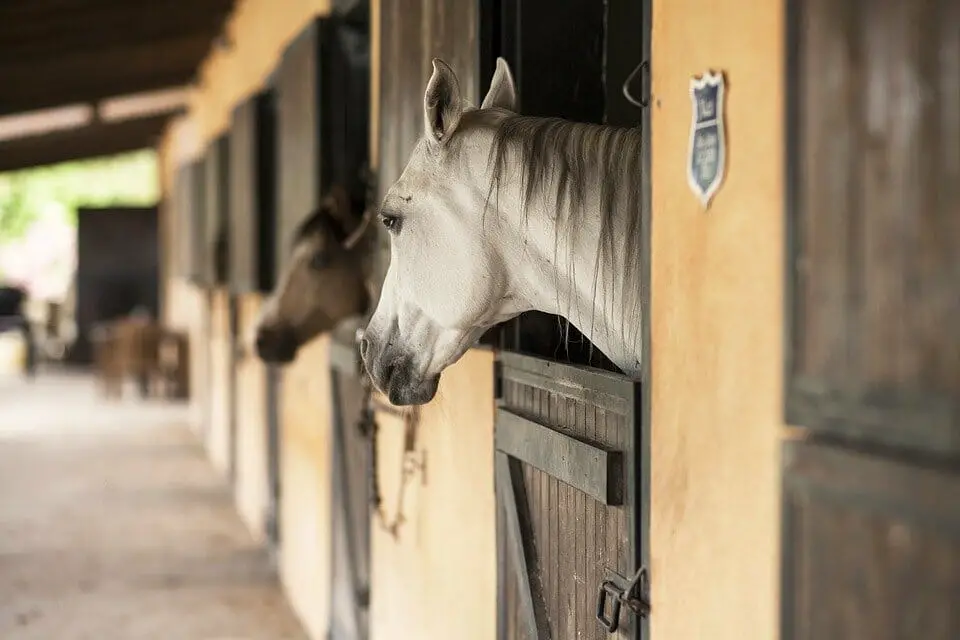
Sweep The Barn Aisle
Bringing horses inside and out, giving out hay, mucking stalls and general barn work creates a mess of debris in the aisle. It looks sloppy and unkempt.
Sweeping the aisle is a regular task that must be done on a continual basis to keep the barn looking spiffy.
The barn will most likely need a good sweeping at least twice a day, possibly more with grooming horses and feeding hay or moving hay.

Pick Out And Inspect Horses Hooves
It is a good practice to pick out your horse’s hooves daily. This helps prevent thrush and other bacterial infections. It gives you a chance to look over the horse’s hooves for cracks, rocks that may be wedged in the grooves, loose or missing shoes, soreness, and bruising.
You can decide what time of the day is best for you to pick out your horse’s feet. I would pick out my horses feet when I would work with them or ride. And on days that I didn’t ride I would pick out my horses feet when I turned in for the evening.
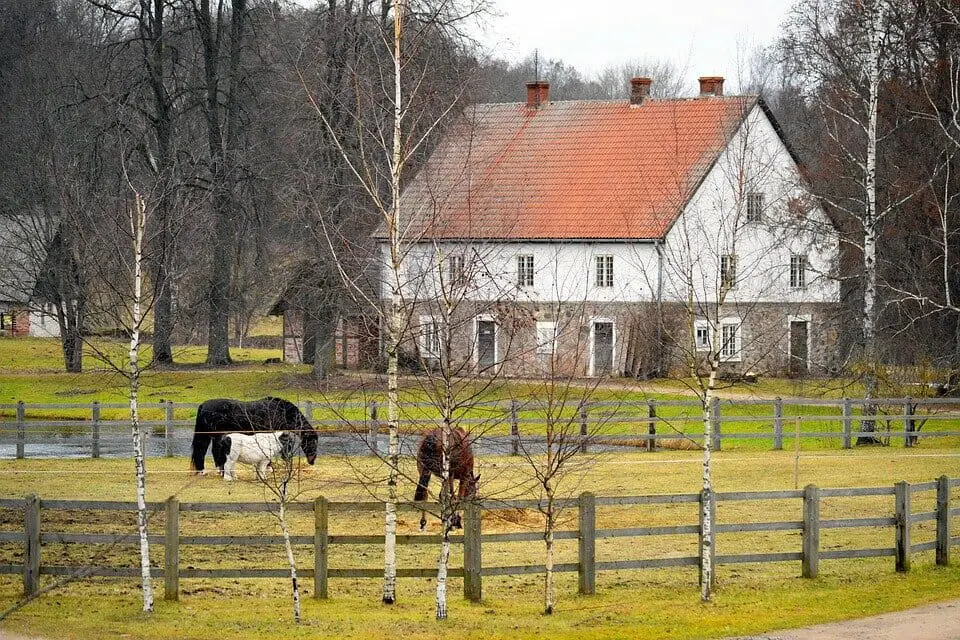
Check Over Areas Horse Are Kept In
Everyday you want to make sure that you do a quick look over of the stall and the turnout area your horses get put into. You should be checking for potential hazards because if there is something that can hurt your horse it probably will at some point.
Look for broken boards, sharp items, broken latches, hay nets that have fallen on the ground or anything that is out of place or not as it should be. This will help keep your horse from getting injuries that could have been prevented.
Horse Should Be Brought Inside During Bad Weather
Bad weather includes thunderstorms, hail, heavy rain, extreme cold, extreme winds, blizzards, that kind of weather.
Horses tend to like to stay outside in most weather but in these circumstances, most horses like a shelter from these elements and it is safer for your horse. I have heard from a couple horse owners from the years who have had horses struck by lightning.
At the very least your horse should have a secure outdoor shelter with 3 solid sides facing away from where the wind usually blows.
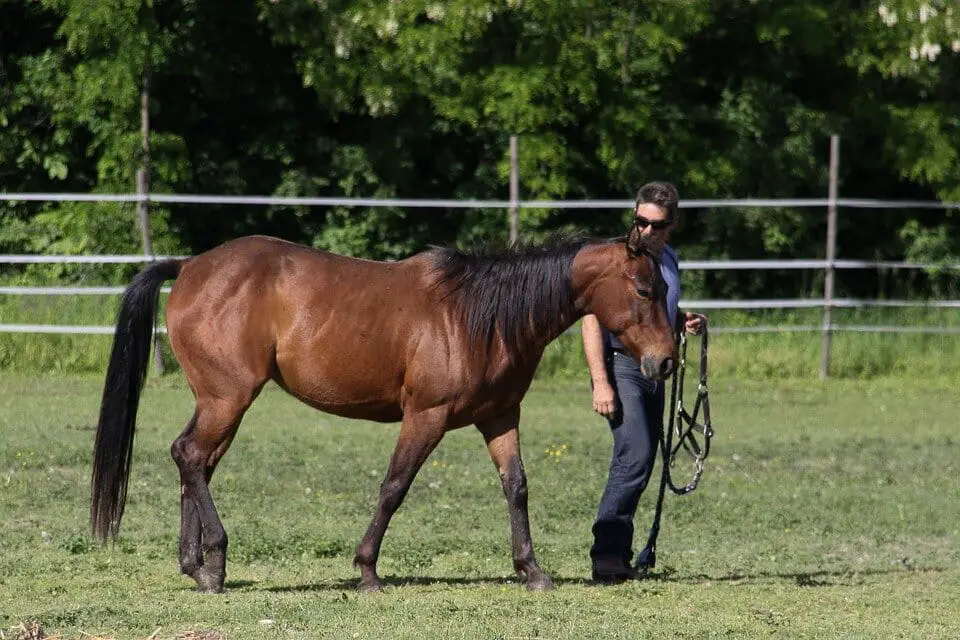
Check Horse Over For Illness And Injury
One way you can do this is with a quick daily grooming. This can give you a chance to inspect your horse’s body legs and face for any cuts, injuries or skin problems.
When you go to bring your horse in or outside check that your horse is drinking water, eating their food.
Pay attention to your horse’s demeanor, are they acting like themselves or do they seem lethargic? Are they more anxious than normal? Are they sound when you lead them to the barn or the paddock?
Remove Cobwebs And Shavings To Prevent Fires
Spiders are master building and cobwebs can build up fairly quickly around the barn. Often you find them pretty much most places around the barn, the walls, the stall bars, the ceiling, the light bulbs, electrical outlets.
This is a fire hazard because they are pretty flammable. So a spark from the outlet or lightbulb could start a fire.
It is a good idea to just include a quick cobweb routine in the daily barn chores. I would de-cobweb as I mucked stalls. I kept a broom with me and quickly sweep the cobwebs in each stall and around the front of the stall as I went stall to stall.

Free Daily Horse Care Am + Pm Routine Printable
Use this Daily Horse Care Routine Checklist to make sure:
- everything gets done
- you save time
- things are done in an efficient order
I suggest using a clipboard and a hook and just keeping it hung up in the barn. This is great if someone who may be helping out at the barn and doesn’t know the routine.
Of course all barns do their routines differently so this is just an idea and a general guideline.
I hope you find it helpful! I had fun making it.
You can grab it here.
There are other free printables on my site and more to come.
Cheers, Kacey


Thank you??? Valuable information!
Your welcome. Glad I could help. ?